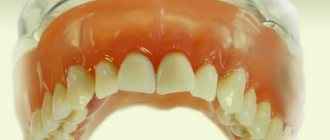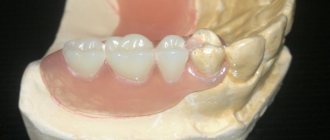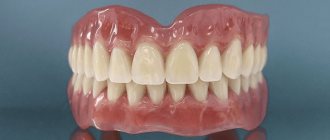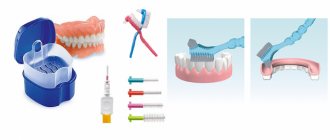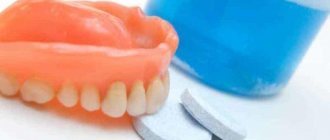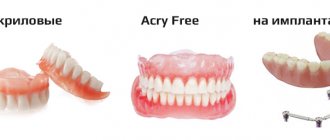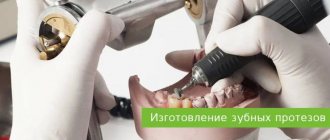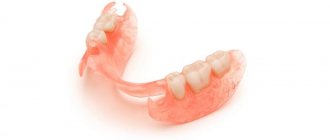Removable dental bridges and dentures are in great demand due to their affordable cost. Removable dentures are used for complete or partial loss of teeth, as well as as a temporary solution until a fixed structure is installed.
It should be noted that modern prosthetics are very different from the bulky and uncomfortable products of the last century. Now they look more aesthetically pleasing, have a natural appearance, fit tightly to the gums and are securely fixed.
Indications for removable prosthetics can also be inflammation of the gums, bone deficiency, or contraindications to the installation of dental implants.
Installation Features
Removable structures have a base that imitates natural gums. Therefore, they look natural, like natural teeth.
In case of complete edentia, the removable denture is attached directly to the gums. The prosthesis fits tightly to the soft tissues, without displacement or loosening.
The prosthesis is fixed using clasps, hooks or implants. The lower part is attached to the roots of the natural teeth, and the upper part is attached inside the base of the structure. If the prosthesis replaces the entire dentition, then fixation occurs only on the gums.
Clasp designs
Some of the most effective, comfortable and reliable are clasp dentures. They consist of a metal frame, a plastic base and artificial teeth. Among the advantageous differences of such structures is the distribution of load between the jaw bone and supporting dental units. Plastic plate dentures do not have this advantage, since when they are used, all the pressure falls mainly on the gum.
Methods of fastening clasp prosthetic systems:
- Metal hook-clasps. They are attached to the teeth adjacent to the defect.
- Locking connections, or attachments. Consist of two elements. One of them is attached to an artificial prosthesis, and the second is attached to an artificial crown that covers the supporting tooth.
- Telescopic crowns. This method of fixation increases the cost of the structure, so it is used less often.
Types of removable dentures
Dentures for complete absence of teeth
These removable dentures are a lightweight, curved plastic plate that covers the entire jaw and palate (if used on the upper jaw). Artificial teeth (made of plastic or porcelain) are attached to it. The removable bridge is fixed due to the natural suction effect of the gums. The use of removable structures is possible only in the case of complete edentia (loss of all teeth).
Conditionally removable orthopedic prostheses
Such removable dentures can be used in case of loss of single teeth (for example, chewing teeth) or in case of significant violations of the integrity of the dentition (loss of a group of teeth). These orthopedic elements can also act as temporary structures. To fix them on natural teeth, special locks (clasps) are used. The component is made of durable metal, which ensures its reliable installation.
It is important to understand that not all partial denture materials are suitable for restoring teeth in the smile area. Therefore, in the case of restoration of the front teeth, it is better to choose removable dentures on implants.
Lamellar
This type of plate dentures is most often used in cases of loss of chewing teeth. This is one of the simplest and most affordable removable dentures.
Removable sectors or segments.
They are unilateral partially removable dentures used when several chewing teeth are lost in a row on one side of the jaw.
Immediate dentures
This is a temporary structure. This product is designed to hold adjacent teeth in place and protect gums until a permanent denture or crown is fabricated. Externally, an immediate denture looks like an ordinary tooth, but on the sides it has special clippers in the form of wings, with the help of which it is secured to the gum. Thanks to these fastenings, it received its second name - “butterfly”
Fixing powder
It is made from sodium alginate, which contains natural substances that are biologically compatible with living gum tissue. The principle of using the powder is the same as that of a cream or fixing pad. A small amount of fixing powder is applied to the previously cleaned denture, the device is immediately put on the teeth and bonding occurs. Fixing powder, unlike fixing creams or pads, is usually available without aromatic or flavoring additives.
Modern materials
Removable acrylic dentures
Budget option based on polymers. Conventional plastic dentures strongly rub the gums and do not fit well. However, our laboratory specialists use a special formula - a new generation acrylic prosthesis, with the addition of crushed diamond chips. The design is more resistant to chewing loads, comfortable to wear and has an aesthetic appearance, and also provides a longer service life.
Elastic
These can be soft nylon or thin removable dentures made of acrylic resins (Acry Free). The material adheres tightly to the gum tissue in the oral cavity. Does not cause pain or discomfort. Can be used for bruxism.
Who is suitable for nylon prostheses?
The use of removable nylon dentures is acceptable in the absence of one or several teeth. The products are used in cases of lack of extreme, lateral or front teeth in a row and even in cases of complete edentia. Edentia is commonly understood as the absence of all teeth in a row or jaw. The use of removable dentures made of nylon is possible for sensitive and weak gums, as well as for restoring dentition in children. Such orthopedic products do not contain metal compounds and are excellent for patients with allergic reactions. As for nylon itself, it is absolutely hypoallergenic.
With locks (sandwich dentures)
Installation requires two healthy tooth roots. One part of the lock is attached to the dental bridge, the second (abutment) is fixed in the root of the tooth. The prosthesis does not have a septum in the palate, which ensures maximum taste sensitivity. Thanks to the partial overlap, the removable denture can be worn for several days, only being removed for cleaning.
Dentures on implants
The most popular type of prosthesis. It is securely attached to the gum due to four supports connected to each other by a beam. Removable dentures on implants provide an even load on the jawbone, and the absence of a palate in the structure guarantees a natural taste perception when eating. It is easy to use, has a long service life and can be easily replaced with a new one if necessary. The only drawback is the high cost of installation due to the materials used. However, the price is fully justified by the quality, comfort and durability of the product.
Clasp dentures
This type of prosthesis is suitable for complete and partial restorations. Due to its aesthetics and affordable price, removable clasp dentures are in high demand among patients in dental clinics.
When making a removable clasp denture, specialists use a base made of elastic plastic, to which a metal beam is attached. Dental crowns made of artificial materials are fixed on the latter. Depending on the type of structure and the wishes of the patient, crowns on a dental bridge can be made of plastic, metal or metal-ceramics.
A partially removable denture is attached using clasp hooks if there are native supporting teeth. Or it could be a hidden mechanism that connects the crown to the base of the tooth. The clasp bridge is easy to use - it does not need to be removed before going to bed.
Fixed dentures on implants
Classic implantation. This method of restoring teeth in the absence of teeth makes it possible to reproduce functionally and aesthetically natural teeth as closely as possible.
This procedure occurs in 2 stages. During the first stage, implants are installed. The second stage is carried out after about 3 - 6 months - the time for the implants to engraft into the bone. The second stage is the installation of dentures on implants. Single crowns (more expensive) or bridge structures (cheaper) can be used as prostheses. These dentures are similar to conventional ceramic ones; they are simply installed on implants.
The frame material of the structure can be an alloy of chromium and cobalt or the more expensive zirconium dioxide. And for patients with allergies to metals, zirconium dioxide is the only option for implant prosthetics.
The use of such prostheses is comfortable, does not cover the gums and palate, and does not require getting used to. They are also more aesthetically pleasing and do not attract the attention of others.
Advantages: durability, lightness of construction, preservation of taste sensations, absence of a gag reflex, complete uniform chewing, and restoration of dental function by 90%.
The disadvantages are high cost, duration of treatment, and sometimes the need for bone grafting.
Fastening methods
For complete restoration of the dentition, a spherical or beam method of fastening is used. The first method is used only for fixing 1-2 implants, due to the mobility of the fasteners. A removable denture on a bar provides a strong and reliable fastening of the structure in the mouth. Does not move when talking or eating. Due to the high precision of installation, the patient’s natural bite is restored.
There is a third, screw method: A removable denture is attached directly to implants installed in the bone tissue. Advantages of the method: maximum accuracy of installation, uniform distribution of load on the jaw, high aesthetics.
Fixed crowns and bridges
Two methods can be used to install single crowns or bridge structures:
- For cement. Traditionally, dental prostheses are fixed using a hardening mass. This is a special dental cement that, after hardening, reliably connects the crown and the supporting part.
- On the screw. This method is used only when installing a crown on an implant, along with cement fixation. The screw is inserted into the abutment through the hole in the prosthesis and tightened using a special key.
Fitting and installation
The installation process will take only 2-3 days, and will require 3 visits to the doctor.
The initial stage includes a primary diagnosis of the oral cavity, the condition of the teeth and gums, as well as taking an impression. The production of a removable denture will take from 3 to 14 days, depending on the type of design chosen.
At the stage of installing a removable denture, it is important to assess the level of comfort when wearing it. It is important that the patient does not experience pain during fitting and does not rub the gums.
At the final stage, the doctor secures the prosthesis with clasps and tells the patient how to use and care for it.
In the case of implants with bar fasteners, support rods are first fixed in the jaw tissue. A short break will be required for implantation. After this, a completely removable denture is installed.
If the patient does not have the opportunity to undergo a rehabilitation period, an alternative may be implantation technology with immediate loading. In this case, tooth restoration takes 1-2 days.
With proper use, a removable denture will last you 7-10 years. If damage occurs, it can be repaired, but if the base is damaged or the dental crowns are severely deformed, then our experts recommend replacing the denture with a new one to eliminate the risk of injury to the oral cavity and infection.
Basal implantation
This method comes to the rescue when the patient’s oral cavity does not have the conditions for classical dental implantation - this is a high degree of thinning of the bone tissue and the impossibility of bone grafting. Implants are placed in the basal bone of the jaw, which is largely free from atrophy. Such implants are individually selected depending on the size of the bone and its quality. Metal roots are attached at a certain angle, deep into the bone. The installation of implants and prosthetics takes one week.
There is no need to talk about aesthetics in this case; basal implantation is used if there are no other options for restoring teeth.
The main advantages of basal implantation are lower cost, the possibility of implantation even in the absence of alveolar bone, no need to build up atrophied bone, low cost and short treatment time.
The disadvantages of basal implantation are poor aesthetics and the impossibility of installing a single implant. In addition, if the doctor acts ineptly, there is a risk of harming the patient more than helping him. The qualifications of the doctor play a decisive role when choosing this method of prosthetics.
Advantages of removable dentures
Installing a denture helps restore the aesthetics of the dentition. However, this is not its main function. Missing teeth leads to a number of problems: poor digestion, displacement of existing teeth, asymmetry of the facial muscles and difficulties with diction.
Removable prosthetics is an affordable method that helps solve the problem of complete or partial edentia.
Modern dentures are hypoallergenic and safe. High-quality materials allow us to develop durable structures with strong fixation in the oral cavity.
ACRI-FRI - prostheses that do not break
ACRI-FRI is the latest material for removable denture bases, high strength.
Denture bases are made by injection molding from acrylic resin. Does not contain polymethyl methacrylate or methyl methacrylate.
- Increased strength characteristics (do not break)
- Possibility of use for any dental defects
- Excellent reproduction of the relief of the oral cavity
- High hygiene due to extremely low water absorption and non-survival of microorganisms
- Long service life
- Fits exactly, does not deform
- Does not cause allergies
Prostheses made from the latest VERTEX (see picture) have long been loved by our patients, whose comfort cannot be compared with any acrylic plate prosthesis.
VERTEX is the latest hot polymerization plastic, high strength with the addition of silicone for the manufacture of partial, complete removable dentures, as well as for complete dentures supported by implants.
To increase comfort and quick adaptation, a soft silicone gasket with a long shelf life made of VERTEX SOFT material is used. Its advantages:
- Does not absorb odors
- Doesn't peel off
- Polymerizes together with the prosthesis base
Care
Cleaning a removable denture is not much different from cleaning natural teeth. Although it has its own characteristics.
After each meal, it is recommended to rinse them thoroughly with water. This will prevent bacteria and infection from entering the gums.
It is better to clean it with professional products suitable for its material. If the structure is completely removable, it is recommended to leave it in a disinfectant solution before going to bed.
Periodically check the denture for cracks and chips. If any damage is found, consult a doctor immediately.
For preventive purposes, it is important to visit the dentist at least once every six months. The specialist will conduct a professional examination, check the condition of the jaw and gum tissue, and also clean the dental bridge from contamination.
Alternative solutions
Atrophy of the jaw tissue becomes a serious argument in favor of fixed prosthetics. In the case of complete adentia due to bone deficiency, the optimal solution is immediate implantation, with fixation of the prosthesis for 2-3 days.
This technology includes All-on-4 and All-on-6 punctures. For installation, 4 and 6 dental implants are used, depending on the condition of the bone tissue. This technology allows you to fix a removable denture immediately after installing the implants.
Titanium rods are almost completely fused with the jaw bone. The prosthesis is tightly fixed to the implants, without the risk of displacement, and it can be loaded immediately after its installation.
The operation includes several stages:
- Initial examination, hardware diagnostics using 3D modeling technology.
- Preparing the jaw for implantation - removing decayed teeth, choosing a site for installing implants.
- Fixation of titanium rods in a gentle manner, with minimal surgical intervention (without deep incisions).
EspaDent's own dental laboratory allows us to produce a removable dental prosthesis in the shortest possible time, without loss of quality or extra costs.
Stages and timing of dental prosthetics
The specific plan and order of all dental prosthetic measures in each individual case may be different, depending on which teeth are to be restored, what technology is chosen, etc. Any procedure always begins with an examination of the patient, assessment of the condition of the dentition and the necessary diagnostic procedures.
After this, the doctor, together with the patient, develops a detailed treatment plan. The stages of dental prosthetics may include grinding down teeth - to install veneers or crowns, or to fix a bridge or clasp prosthesis. Another important stage is taking impressions, from which the dental technician will make crowns or dentures.
The accuracy of the fit of the prosthesis and the ease of use in the future depend on the quality and accuracy of this procedure and the choice of the most suitable material. In order for everything to be done with the utmost precision, jaw modeling programs are used, the work of the jaw joints and muscles is revealed, and the closure of the teeth of the upper and lower rows is studied.
A mandatory stage of the dental prosthetics process is the manufacture of the prosthesis in the laboratory. This is labor-intensive jewelry work, the quality of which determines how successful the fitting of the design will be, whether adjustment is needed, how comfortable the use of the prosthesis will be for the patient, how quickly one can get used to it and how long the system will last.
After the prosthesis is made, it is tried on, modified if necessary, and then fixed. Very often, before installing a permanent option, which may take several months, the patient is given temporary structures, which will need to be dismantled before installing a permanent structure. And finally, after installation of the prosthesis, there is an adaptation period.
In the case of prosthetics on implants and installation of anatomically accurate structures, adaptation takes a matter of days. When installing complex and removable bridges, getting used to it can take a month. In general, it is simply impossible to say in advance how long prosthetics will take. This can only be determined by a doctor after examining a particular patient and choosing the surgical technology.
Preparing teeth for the procedure
Before the procedure, it is necessary to carry out a number of activities, which can take from one to several months. In particular, you will need to carry out professional oral hygiene and cure all your teeth. It may then be necessary to remove non-restorable teeth and their roots, and sometimes also to correct the bite or position of the teeth using braces.
If implantation is planned, it may require bone grafting. Therapeutic preparation of teeth for prosthetics includes complete sanitation of the oral cavity - professional cleaning, removal of tartar, treatment of caries and periodontitis, depulpation of those teeth that cannot be cured in any other way and those that are intended for grinding to fix dentures.
The surgical preparation stage involves the removal of severely damaged and incurable teeth, removal of soft and hard tissue pathologies, bone augmentation before implantation (for example, sinus lift), as well as the implantation operation itself. The orthodontic and orthopedic stages involve correcting the bite and straightening the teeth using braces.
This is important not only for beauty, but also to ensure that the load after installation of the prosthesis is distributed evenly - the health of the remaining teeth and the service life of the prosthesis depend on this. Protruding teeth are also sharpened and secondary deformities are corrected. All stages of preparation are extremely important and directly affect the quality of the procedure, ease of use of the prosthesis and its durability.
Selecting a method
Which dental prosthetics to choose in a particular case is determined by the nature and scale of dental defects - how many and what teeth are missing, how healthy the existing teeth are and what methods need to be used for their treatment and restoration. This will also require the necessary diagnostics - x-rays, tomography, laboratory tests, studying the patient’s health status.
Of course, the patient’s requirements play an important role - what result is needed and what financial capabilities he has. Some patients are willing to wait several months, while others need urgent prosthetics. Some agree to implantation, while others are contraindicated for medical reasons. In each specific case, the choice of technique and procedure plan is a compromise between desires and capabilities.
How are dentures made?
The manufacture of the prosthesis itself does not greatly affect the time of dental prosthetics - it takes only a few days. Much more time is spent on preparatory procedures, waiting for implants to heal, and adaptation to the finished structure.
After impressions are made and digital 3D models of the jaw are created, the impressions are transferred to plaster casts in the dental laboratory. Subsequently, structures made of titanium, zirconium dioxide, various alloys, and polymer materials are created using special equipment. Ceramic crowns require firing and sometimes painting. Installation of a finished structure
The manufactured prosthesis must be tried on. If the fit is incomplete or inaccurate, the doctor corrects it or sends it to the laboratory. If it fits perfectly, the doctor fixes it in the oral cavity. Correction may be required in the future due to changes in the tone of the masticatory muscles, malocclusion, and bone tissue atrophy due to the lack of chewing load on the bone.
Next, the doctor instructs the patient how to use the denture - what can be chewed and what cannot, how often and thoroughly should be cleaned, when to come for an appointment to inspect the structure, professional cleaning, and, if necessary, repair or replace components.
How are dentures attached if the last supporting teeth are missing?
If we mean a complete absence of teeth, then various types of complete prosthetics, which we discussed above, are suitable. If the teeth are preserved, for example, in front and we are only talking about restoring the lateral chewing teeth, then it is possible either clasp prosthetics on implants (which will provide the necessary support for the prosthesis), or the installation of removable dentures made of acrylic or nylon, or clasp prosthetics with support on the front ones teeth.
Examples of prostheses made in our laboratory
Thermoplastic (clasp) "Quattroti".
ACRY FREE (acrylic free).
Nylon removable denture.
The article was checked by: Meleshkin Dmitry Vladimirovich
If you liked this post, share it with your friends and subscribers.
